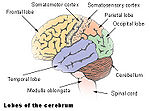Attention deficit disorder
Attention deficit disorder is a mental disorder that affects attentiveness, hyperactiveness, and impulsiveness. It affects anywhere from 3 to 5% of children, and between 30-70% of these still have ADD into adulthood.Cite error: Invalid <ref> tag; invalid names, e.g. too many Attention Deficit Disorder can drastically affect people affected by it because it makes every day tasks much harder to accomplish. ADD affects the part of the brain that deals with comprehension, attentivity, hyperactivity, and impulsivity. People who have ADD experience brain activity above the level of people without the disorder. This hyperactivity causes inattentiveness and makes it hard to concentrate. ADD is still not fully understood by the scientific community. Doctors have been studying the disorder for years and know that ADD is often hereditary, but can also be acquired at a young age from overexposure to certain chemicals or environments.
History
In 1902, Dr. Still gave lectures at the Royal College of Physicians in England. He spoke about a condition synonymous to ADHD, he had come to this conclusion by analyzing a group of children with hereditary problems of serious misbehavior. Dr. Still called this condition “Morbid Defect of Moral Control.” This name was replaced by “Post-Encephalitic Behavior Disorders", and was changed to “Minimal Brain Dysfunction” or ” restlessness syndrome” 20 years later.[1]
The term "Attention Deficit Disorder" was not acquired until the 1960's. This name was not yet official though. The name was highly reviewed until the 80's when "Attention Deficit Disorder" became the official name according to in the DSM III by the American Psychiatric Association. In the 60's, before ADD was recognized as an official disorder, doctors focused on patients hyperactivity. In the 70's physicians "Making connections between patients tendency toward inward daydreaming and their resultant external lack of focus, impulsivity, and hyperactivity." ADD is now a widely studied, discussed, debated and diagnosed condition.[2]
Cause
Although no one knows exactly what causes ADD, experts think that it is strongly influenced by your genetics. ADD seems to run in families. Studies have shown certain genetic characteristics that occur in families where one or more family members have ADD. Also, if one or both parents have ADD, their children are more likely to develop the disorder. At least one-third of all fathers or mothers who had ADD in their youth produce children with ADD. They know that ADD is caused by differences in the neurotransmitters in the brain. Sometimes ADD is not genetic at all; it can be caused by smoking or drinking while pregnant. Premature or very light babies have a higher risk of having complications with ADD. Children that have head injuries to their frontal lobes or have over exposure to lead and pesticides have a much higher chance of developing ADD. [3]
ADD always begins in childhood; many times though, people are not diagnosed with ADD until adulthood. These adults with ADD have had to deal with the symptoms of ADD for years as they mature. Studies show that 30 to 70% of children with ADD still have the symptoms of ADD even in adulthood.[3]
Studies tend to show that people with ADD have abnormal brain chemical functions and the nerve passageways show irregular behavior. People with ADD can also have certain parts of the brain that are smaller or are less active than other peoples. Dopamine, a very important chemical that sends and receives signals throughout the brain, seems to be a big factor in ADD.[3]
Symptoms
The most common symptoms of ADHD include short attentiveness, hyperactiveness, and impulsiveness. Attention Deficit Disorder can be hard to diagnose. Sometimes a patient can show some signs of ADD but not actually have the disorder. The disorder is generally diagnosed based on the patients age and behavior. This disorder is most common in children and teens, but not excluded to these groups. Adults can also have ADD, but the symptoms are usually different. Instead of being hyperactive, they have an overwhelming feeling of restlessness. These adult patients also have difficulty maintaining , and being consistent in interpersonal relationships as well as their employment.[4]
There are three main types of ADHD: "combined ADHD", the most common in which all of the symptoms are present in the patient, "inattentive ADHD", which causes the patient to have a hard time concentrating; and "hyperactive-impulsive ADHD", this last type primarily effects the patients hyperactivity level without causing them to have a hard time concentrating. For someone to be diagnosed with ADHD, the person has to show the symptoms of ADHD in more than one setting. Once again, the symptoms of ADHD are inattentiveness, hyperactivity, and impulsivity. Inattention causes the person to not be able to concentrate on important things such as homework and paperwork. Hyperactivity causes restlessness usually in younger children. These patients usually have a hard time sitting still. These people will usually constantly be moving to stay active. Impulsivity causes the patient to be very impatient. It makes it hard for the person to wait on others, even for short amounts of time.[4]
Treatment
The best thing to do when you are diagnosed with ADHD is so try to resolve the problem so you can get back to normal life once again. The most popular treatments for ADHD are either medical or psychological. Adults will commonly use medications to resolve the problem. Children and teens more commonly try to manage lifestyle or behavioral issues, but a medical treatment is one of the best ways to help with your ADHD. The most successful way to completely rid yourself of ADHD symptoms is to take medicine and to get counseling to help figure out exactly what causes the ADHD symptoms. If the patient decides to use medicine to treat their symptoms, there are three main psycho stimulants that are the most effective: Methylphenidate, Dexedrine, and Pemoline. If a psycho stimulant is not wanted, there is a non-stimulant medicine called Strattera (atomoxetine)that blocks norepinephrine receptors in the brain. This type of medicine has been shown to greatly reduce hyperactivity and the inability to focus, work, and learn.[4]
References
- ↑ History of ADHD as a recognized disorder History of ADHD as a recognized disorder . Web. Last Updated 9/27/08
- ↑ What is the History of ADD/ADHD LD Resources Foundation. Web.
- ↑ 3.0 3.1 3.2 What is the best diet for ADHD? ADDHopeInHayward. Web. Last updated august 10, 2012.
- ↑ 4.0 4.1 4.2 Attention Deficit Hyperactivity Disorder: Symptoms of ADHD WebMD. Web. Accessed November 29, 2012
| ||||||||||||||||||||


